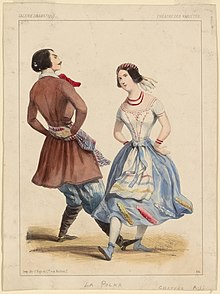
Polka - fast, lively Central European dance, as well as the genre of dance music. The musical size of the polka is 2/4 . Polka appeared in the middle of the XIX century in Bohemia (modern Czech Republic), and since then has become a folk dance .
Content
Description
According to legend, the polka, invented by a maid from Bohemia, Anna Slezak (Slezakova) in the 1830s, quickly became popular in European cities. In Paris, aristocrats unsuccessfully tried to ban "indecent dance", including with the help of the police. In the winter of 1843, the Russian translator Vladimir Solonitsyn wrote that “all Paris went mad: everyone wants to dance polka, everyone learns polka. <...> This dance is not very decent, like a cancan , because in it the ladies have to bend one leg in the knee and lift the heel so high that during this movement the garter of the other leg is visible ” [1] [2] .
Polka was written by Johann Strauss I and his son Johann Strauss II . This genre is often found in the works of Czech composers - Bedrich Smetana , Antonin Dvorak and others.
It is believed that the name of the dance comes from the Czech word půlka [3] [4] , meaning "half step", because the polka rhythm requires you to quickly shift from one foot to the other. Polka is often considered a Polish dance, which is not true. In addition, you should not confuse polka with a Swedish dance ( polska , 3/4 ).
In Russia, the polka appeared in 1845. This dance - then very fashionable in France - was brought back from a trip to Paris by the dancer of the imperial troupe of St. Petersburg Nikolai Osipovich Golts [5] . He put it on stage, and then spread it in high society in St. Petersburg, and the highest aristocratic light soon danced polka at balls and in salons.
Polka, as one of the figures, entered the Russian quadrille . In the south of Russia, the polka became a local dance: in the Voronezh province - “Livenskaya polka”, in Rostov - “Polka-tatsinka”, in the Kuban - “Polka-kastyrka” [6] .
Polka Types
In many European countries there is a version of polka. She is considered a folk dance in Russia, Belarus, Ukraine, the Czech Republic, Poland, Germany, the Scandinavian countries, the republics of the former Yugoslavia and many others. Each nation brought its own characteristics to the dance: Estonian Yoksu-Polka is danced slowly, importantly, Moldovan - temperamental, Belarusian Polka-Kryzhachok , Polka-Yankee - gracefully, Ukrainian Polka-Galichanka and Russians - fun.
Entering the repertoire of ballroom dancing, the polka was supplemented by the ball types: polka-canter , polka-mazurka , polka-cotillion appeared [7] .
See also
- Finnish polka
- Rosamund Polka
- Polka Sykkiyarvi
- Humppa
Notes
- ↑ Germanov VG Dance Dictionary: dances for balls and discos. - Ufa : ASTA, 2009. - p. 302-303. - 449 s. - ISBN 978-5-9901591-1-2 .
- ↑ Milchin V. Paris in 1914-1848: everyday life. - M .: New Literary Review , 2013. - P. 598. - 944 p. - ISBN 978-5-4448-0068-3 .
- ↑ Polka History of Dance
- ↑ "polka". Oxford English Dictionary . Oxford University Press. 2nd ed. 1989.
- ↑ Great biographical encyclopedia. Golts, Nikolay Osipovich
- ↑ Bogdanov G.F. Russian folk dance. Theory and history. Textbook for universities - Moscow: Yurayt, 2019 - 167 p. - ISBN: 978-5-534-09494-7 - p. 36
- ↑ Dance Encyclopedia: Polka
Literature
- Polka / Lyakhova T.L. // Okunev - Simovich. - M .: Soviet encyclopedia: Soviet composer, 1978. - (Encyclopedias. Dictionaries. Directories: Musical Encyclopedia : [in 6 tons.] / Ch. Ed. Yu. V. Keldysh ; 1973-1982, v. 4).
- Germanov V. G. Polka // Dance Dictionary: dances for balls and discos . - M .: ASTA, 2009. - p. 109. - 440 p. - ISBN 978-5-9901591-1-2 .
Links
- Polka Butterfly. Belgorod region., Valuisky district, p. Shelaevo. (youtube.com)
- Polka. Record із with. Luka Kiev-Svyatoshinsky area (youtube.com)